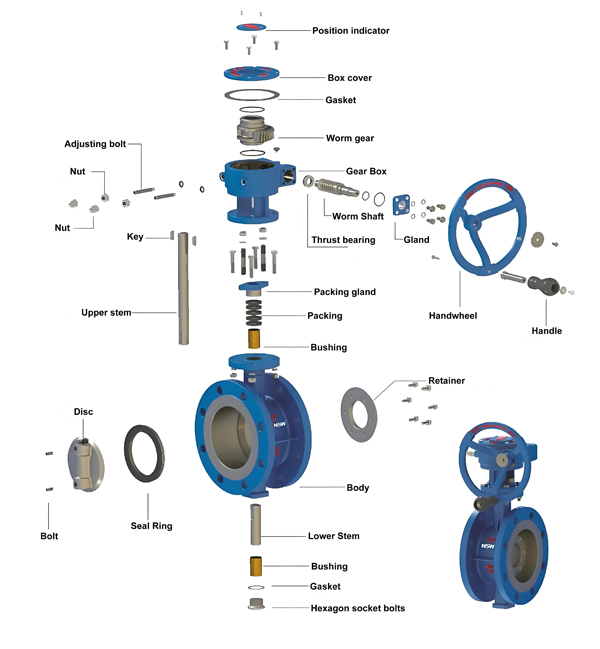What is a Butterfly Valve
A butterfly valve is a quarter-turn valve featuring a rotating disc (butterfly plate) attached to a central stem. This compact design enables quick flow control or isolation in pipelines. Widely used across industries, butterfly valves excel in applications requiring cost-effective, lightweight solutions with low-pressure drop.
Butterfly Valve Structure: 4 Key Components
1. Valve Body: Cylindrical housing (cast iron, stainless steel, or ductile iron) with flanged/lug/weld ends.
2. Valve Disc: Rotating plate controlling flow – available in concentric, double/triple eccentric configurations.
3. Stem: Connects actuator to disc for torque transmission.
4. Seat: Sealing surface (soft rubber, PTFE, or metal) ensuring leak-tight closure.

How Do Butterfly Valves Work
The disc rotates 90° between:
- Fully Open: Disc aligns parallel to flow (minimal pressure loss)
- Fully Closed: Disc blocks flow perpendicular to the pipe
Types of Butterfly Valves
By End Connection Type
- Wafer Butterfly Valve: Flangeless design clamped between pipe flanges
- Lug Butterfly Valve: Threaded inserts for easy pipeline disconnection
- Flange Butterfly Valve: Integrated flanges for bolt-to-bolt mating
- Welded Butterfly Valve: Permanent welded connection for high-integrity systems
By Design
1. Concentric (Centerline) Butterfly Valve
– Disc/stem centered in valve bore
– Budget-friendly for low-pressure water systems
2. Double Eccentric (High-Performance) Butterfly Valve
– Offset stem reduces seat wear
– Handles higher pressures up to 1,480 psi
3. Triple Eccentric Butterfly Valve
– Three offsets (stem, disc, seat angle)
– Metal-seated solution for extreme temps (up to 1,022°F)

By Actuation
- Manual Butterfly Valve: Hand lever/gear operator
- Pneumatic Butterfly Valve: Air-powered pneumatic actuator for rapid cycling
- Electric Butterfly Valve: Motorized control for automation
- Hydraulic Butterfly Valve: Oil-pressure driven for high-torque needs
Butterfly Valve Applications
| Industry | Use Case | Recommended Type |
|———-|———-|——————|
| Water Treatment | Pump isolation | Rubber-lined concentric |
| Oil & Gas | Crude pipelines | Triple eccentric metal-seated |
| HVAC | Chilled water | Lug-style with EPDM seat |
| Food Processing | CIP systems | Sanitary clamp butterfly valve |
Installation & Maintenance Guide
5 Critical Installation Steps
1. Flange Alignment: Ensure pipe flanges are parallel within 0.8mm
2. Gasket Selection: Use PTFE/spiral-wound gaskets for thermal cycles
3. Bolt Tightening: Follow cross-pattern sequence (30-70-100% torque stages)
4. Actuator Orientation: Keep stem horizontal for optimal seal life
5. Post-Install Test: Perform 1.5x pressure test with disc at 10° open
Pro Tip: Always cycle new valves 5-10 times under pressure to seat seals properly.
Maintenance Checklist
- Monthly: Inspect stem packing for leaks
- Quarterly: Lubricate stem bushings with food-grade grease (if applicable)
- Annually: Perform seat leakage test per API 598 standards
Need Expert Butterfly Valve Selection
Newsway Valve Manufacturer provides ISO 9001-certified butterfly valves with 10-year seat warranties. Contact our engineers for a free application review.
Post time: Mar-29-2025






